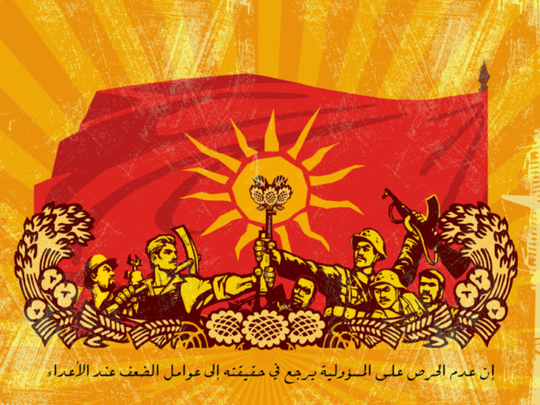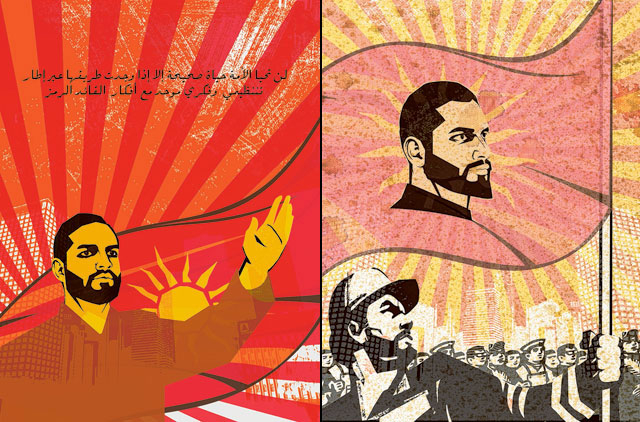
Mahmoud Obaidi’s first solo show in Dubai, “The Replacement”, tells the story of an aborted coup. But, there is a twist in the tale. The Iraqi-Canadian artist is known for the playful manner in which he explores serious sociopolitical issues of displacement, identity and conflict. And in this show he presents a cynical and witty investigation of the art of political propaganda.
Obaidi claims that this show has been inspired by the political campaign of an unknown Arab leader; and that the silk-screen prints, video, sculpture and merchandise he is displaying are reproductions of the posters, stamps, films and other materials that were designed to glorify the leader and present him as a larger-than-life persona, adored by the masses. The show offers deep insights into the mechanisms of manipulation and indoctrination used by authoritarian rulers in their quest for power. It also compels us to think about the ways in which we are influenced by media, advertising and other covert propaganda.
There is an interesting story behind this show. “In 2003, a friend of mine found a collection of boxes in his storage, somewhere in the Middle East. The boxes were filled with political merchandise, propaganda materials, newspapers, magazines and a few film reels. All of them featured a handsome, charismatic Arab man, with an elegantly trimmed beard, dark eyes and an angular jaw. My friend had no idea how the material ended up in his storage, when it was created and whether it had ever been used. Not knowing what to do with it, he contacted a European collector with an interest in historical political paraphernalia, who bought the entire collection. Due to political circumstances, there was a ten-year embargo on making the collection public. When I heard this story from my friend in 2013, after the embargo was lifted, I persuaded him to introduce me to the collector, and convinced him to exhibit his collection in public,” Obaidi says.
The collection brought back old memories for the artist. “The portraits of the leader were a typical communist-style ideological design. It depicted him as the epitome of authoritarian masculine power, smiling benevolently with a well-rehearsed ‘go-forward’ gesture, surrounded by the rays of the sun symbolising his political and divine prowess, and plenty of red to show his passion, power and commitment. I think this material was produced in the 1970s and 1980s, perhaps in preparation for a coup that was called off. And I suspect the Americans or Russians were involved in orchestrating the coup and promoting this leader as a replacement. It reminded me of the political propaganda I grew up with in Baathist Iraq. So, there is something nostalgic about these objects. But they also reflect what is happening today in the region and globally,” he says.
Obaidi decided to show the collection in the Middle East first because the leader is clearly an Arab. “With the current sociopolitical situation in the region, this is a good time to have an exhibition that explores the visual construction and commodification of authoritarian power,” he says.
The exhibition features Obaidi’s reproductions of posters and stamps featuring the leader, which have been modified to remove information that could identify the country. The leader’s aura can also be felt in a corner where his desk and chair have been placed along with photographs of his family; and in the display cases showcasing his personal belongings such as cigars, pipes, lighters, photographs, personalised crockery, and a wallet full of banknotes, with his image printed on them. But there are also mass-produced goods such as T-shirts, mugs, plates, caps, watches (brand name Fanatic) and other merchandise bearing the leader’s image.
Also on display are official documents that provide a rare glimpse into the secret inner workings of an authoritarian regime; and newspapers and magazines featuring articles about the leader. Another interesting object is a copy of a book on photographic art, which was apparently used by the leader to convey coded messages. The choice of book and a sketch made by the leader on its pages indicate his interest in art. Also on display is a film showing the adoring masses welcoming him at the airport, cheering his motorcade and applauding his speech.
After narrating this story with a straight face, Obaidi admits with a mischievous smile that he made it all up. Through this elaborate ruse (which most viewers on opening night believed), the artist powerfully demonstrates the art of propaganda. He holds up a mirror to our society, compelling us to think about the cleverly constructed untruths that are designed to make us believe in things ranging from certain brands and lifestyle choices to specific leaders and ideologies. The care he has taken in conceptualising, designing and producing the materials qualifies them as art. But by deliberately creating confusion between “original” materials and their reproductions, and presenting as artworks cheap, mass-produced consumer goods meant to market a leader, the artist also asks questions about the definition, meaning and value of art in today’s art market. The fact that this kind of seemingly dated propaganda material is used even today for political and visual indoctrination in places such as North Korea and Syria underlines the relevance of this show.
Jyoti Kalsi is an arts enthusiast based in Dubai.
“The Replacement” will run at Meem Gallery until May 1.













